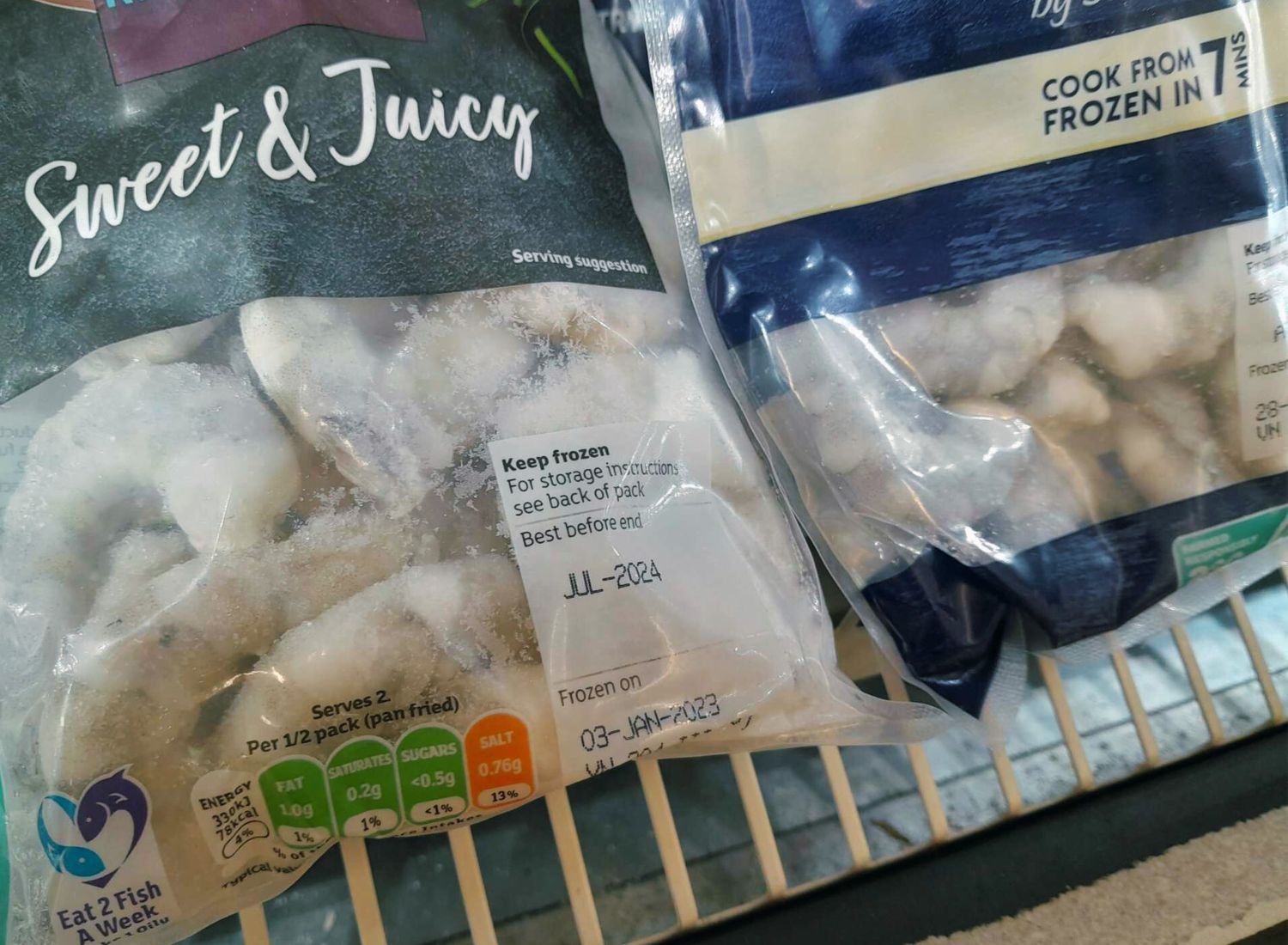You’ve got frozen shrimp and a microwave, but can they team up for a quick meal? Let’s get straight to it. In this article, we’ll tackle the big question: Can you microwave frozen shrimp?
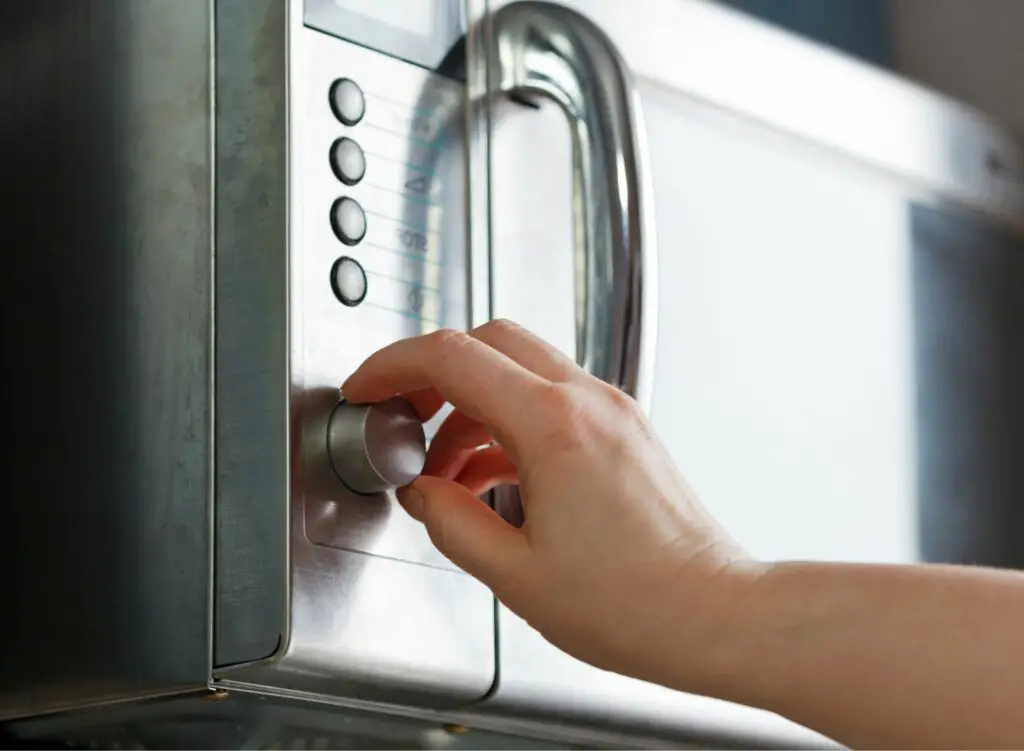
I’ll delve into the safety concerns, examine how it affects texture and flavor, and share tips for getting it just right. Whether you’re thawing or cooking, I’m here to ensure your impromptu shrimp dish is as delectable as ever.
Can You Microwave Frozen Shrimp?
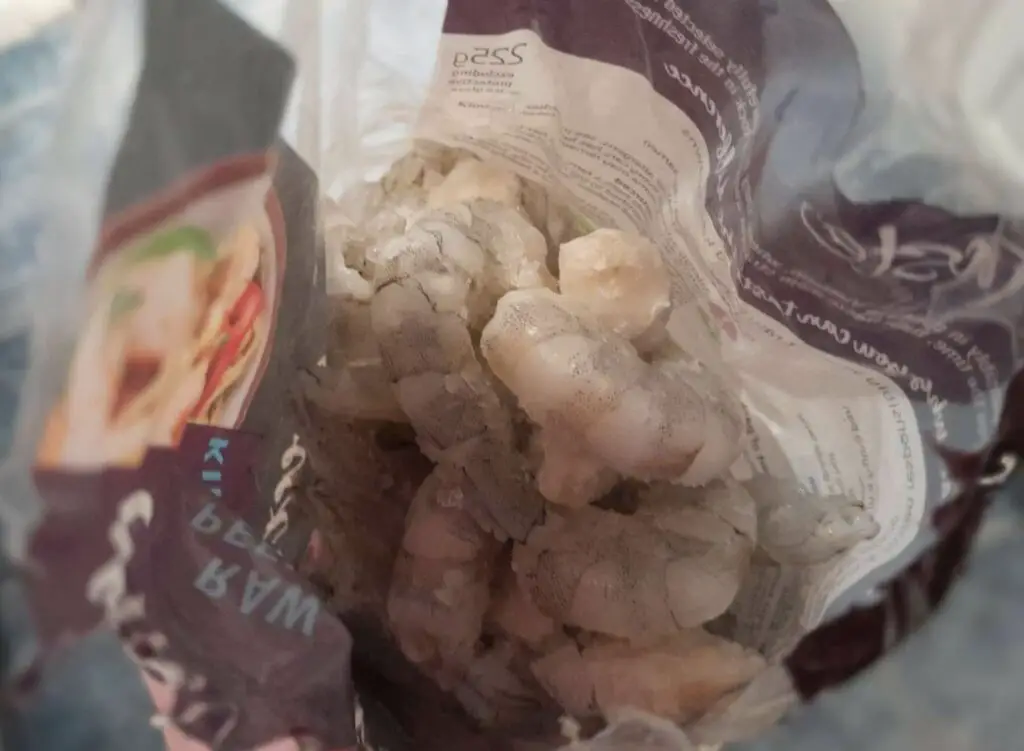
Luckily for all fans of convenience, yes! Microwaving frozen shrimp is safe for your meal—and kitchen—and poses no safety risk. Better yet, you can use your microwave to defrost and cook, making it the ultimate speed-cooking hack.
However, remember it’s not as simple as popping the shrimp in the microwave, pressing the start button, and praying for the best. If you are not careful, you risk overcooking or undercooking your shrimp and ruining your entire meal.
Likewise, using the microwave to defrost shrimp is a valid technique if you’re pressed for time, but it may not be the best. Case in point? Breaded shrimp.
Read Also: 9 Foods That Explode In The Microwave! (Don’t Try This at Home).
Can You Microwave Frozen Breaded Shrimp?

Technically, you can microwave frozen breaded shrimp. However, just because you can doesn’t mean you should—the results would be less-than-pleasant, and it is just not worth the effort.
Why? Well, it all comes down to how fried food and microwaves work.
Microwaves cook—or defrost—by making water particles vibrate and produce heat [1]. As the water heats, it evaporates and transforms into steam, making your food soggy.
If your frozen breaded shrimp are pre-fried, this is basically a death sentence for the crispy crunchiness you know and love. As you can imagine, all that extra steam will hydrate and make the crust soggy and unpleasant, which is the opposite of what you like in fried food.
You might consider using the microwave just to defrost the breaded shrimp, but I’d suggest you avoid it unless you have no other option. It’s easy to overdo it, and frying will be much more challenging with all that extra water going into the oil.
Conclusion? There’s a reason prepackaged frozen breaded shrimp advise you not to use the microwave.
Will Microwaving Affect Frozen Shrimp’s Taste And Texture?
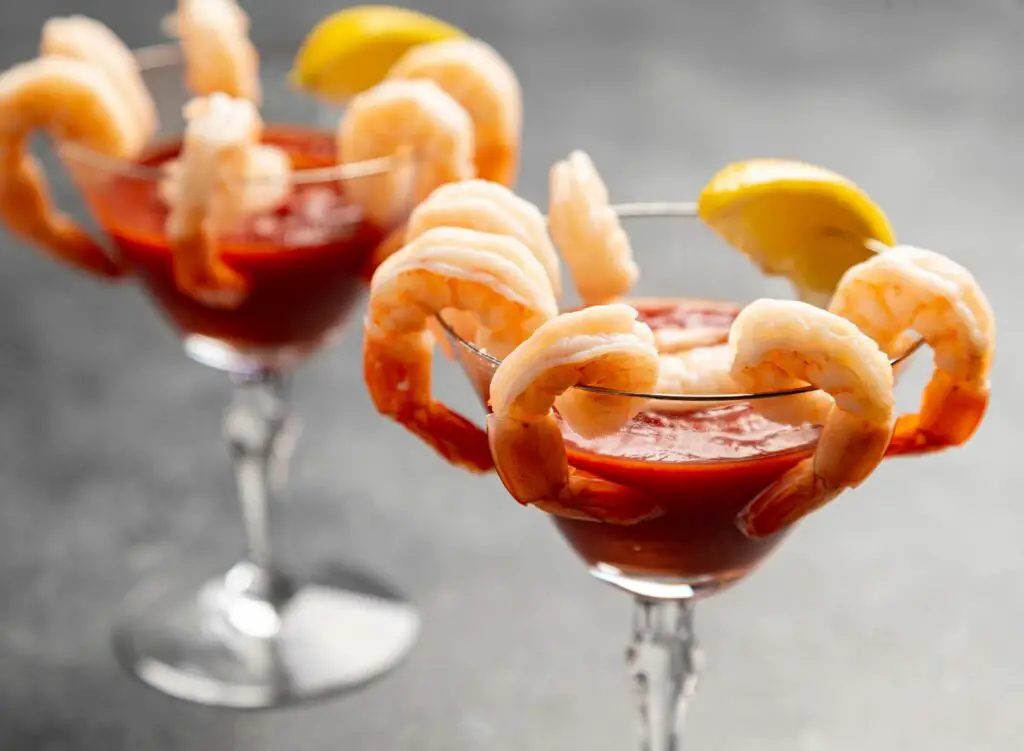
If you’re a cooking whiz like Gordon Ramsay, you might spot right away if shrimp were frozen or zapped in a microwave. But for the rest of us? Well, it can go either way. Like with all things in cooking, what you end up with depends on how you do it. So, frozen shrimp in the microwave can turn out yummy or yucky, depending on how you cook them.
Remember how microwaving works? Well, those heated-up water molecules evaporate very fast, which can overcook and dry out the shrimp, resulting in a chewy and rubbery texture that is not too appealing to eat.
Remember, there is a fine line between properly cooked and overcooked. Shrimp cook very quickly, and in a microwave, they can easily become rubbery and tough if you’re not careful.
Yes, microwaving shrimp is quick, but often a flavor downer due to uneven heating. To boost taste, season or marinate them. However, stovetop, grill, or oven take the flavor trophy.
Microwaves can be moisture thieves, but adding water and covering the dish creates steam, keeping the shrimp juicy. Also, microwaves can be fussy with hot and cold spots, so lay the shrimp in a single layer and shuffle them around for even cooking.
For flavor champions, though, consider ditching the microwave for a stovetop, air fryer, grill, or oven.
However, to make it work in the microwave, the secret is, of course, in the cooking time.
How Long Should You Microwave Raw Frozen Shrimp?

There’s not a one-size-fits-all number I can give you—it all depends on your microwave’s settings, how frozen your shrimp are, and whether or not you aim to thaw or cook.
But while there is no number, there is one rule: less is more. As I said before, there is a fine line between properly cooked and overcooked shrimp, so the shorter your timeframes, the better.
Usually, it takes about 3-4 minutes to thaw a cup of raw frozen shrimp and another 3-5 minutes to cook them but keep an eye on them.
Thawing or cooking your raw frozen shrimp in short microwave bursts reduces the risk of overheating and overcooking. It allows you to keep a close eye on the process while making sure the shrimp never get too hot for too long.
The margin window is quite small, so microwaving frozen shrimp can go wrong quickly. However, I have some tried and tested techniques below for thawing and cooking frozen shrimp in the microwave to ensure your culinary adventure doesn’t shimpry end in disaster.
To recap: To microwave frozen raw shrimp, defrost them by microwaving on the defrost setting for 3-4 minutes per pound, then cook on high for an additional 4-5 minutes. For frozen cooked shrimp, just heat them on the microwave’s high setting for 1-2 minutes till warm enough, since they are already cooked and only need to be warmed through.
How Do You Thaw Frozen Shrimp In The Microwave?
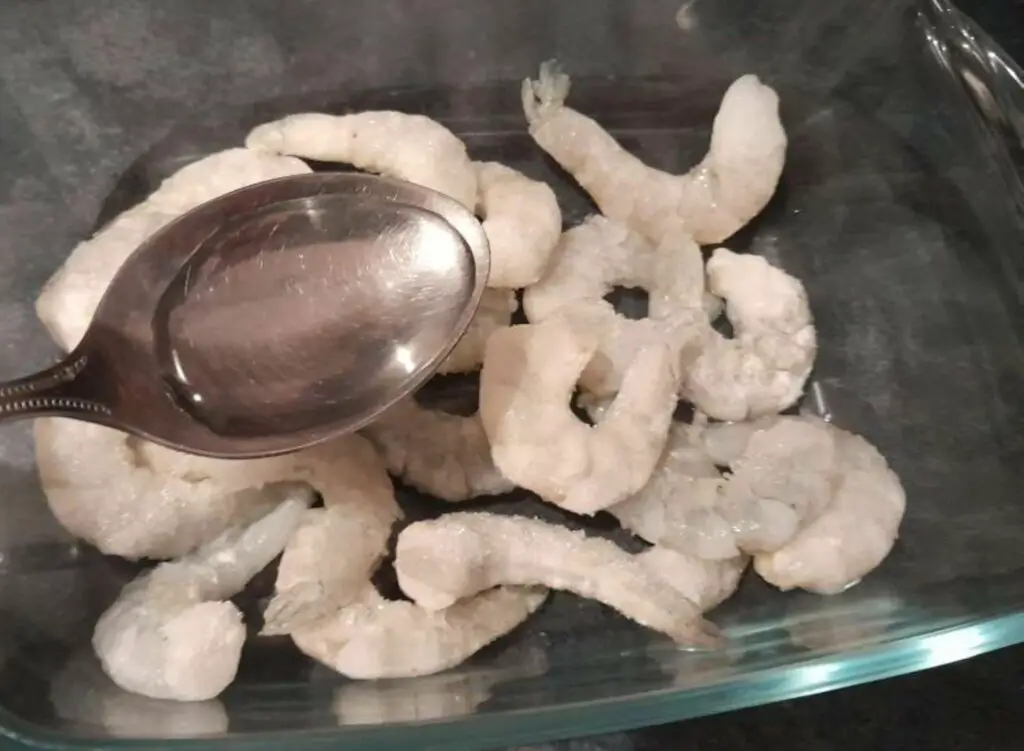
When thawing frozen shrimp in the microwave, your main focus is to get rid of all the ice without overcooking the shrimp, so the secret is in short rounds with lidded dishes but NOT airtight.
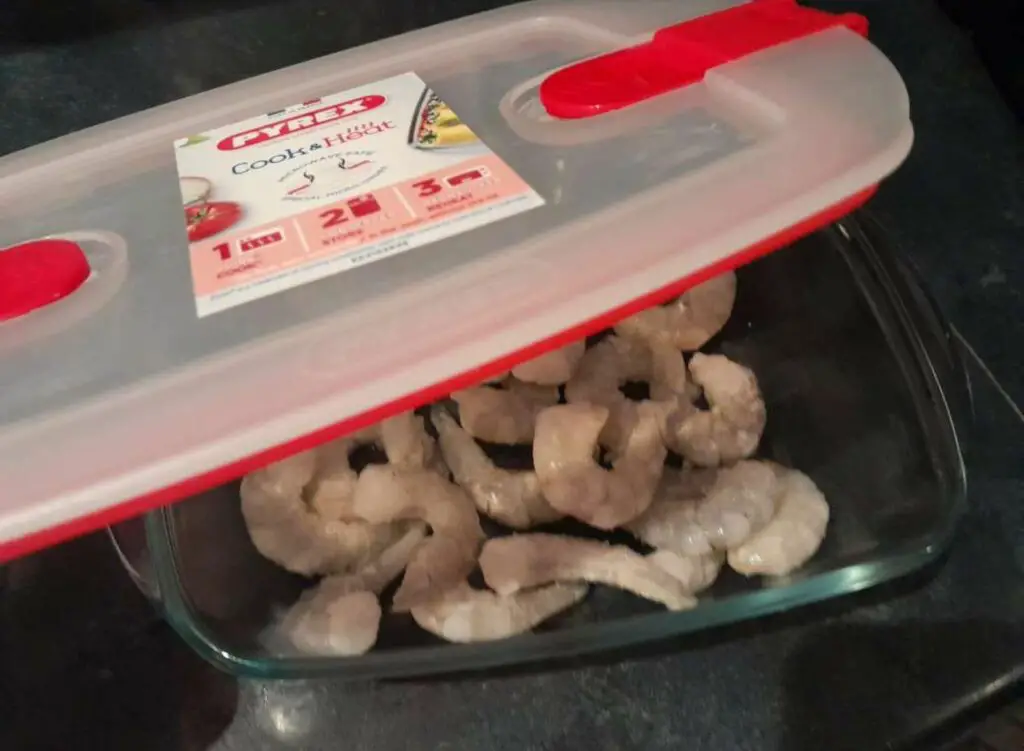
- Put the raw frozen shrimp inside a microwave-safe dish, preferably in a single layer, and add a few tablespoons of cold water to offset the upcoming heat.
- Place the dish in the microwave and heat in the defrosting mode for short intervals of 30 seconds each, leaving a gap of 10 more seconds between each heating session.
- Check the shrimp repeatedly, making sure to stir if needed. Change the water if you notice it has warmed considerably.
While this method can yield excellent results, remember it needs lots of focus to ensure things don’t go awry.
How Do You Cook Frozen Shrimp In The Microwave?
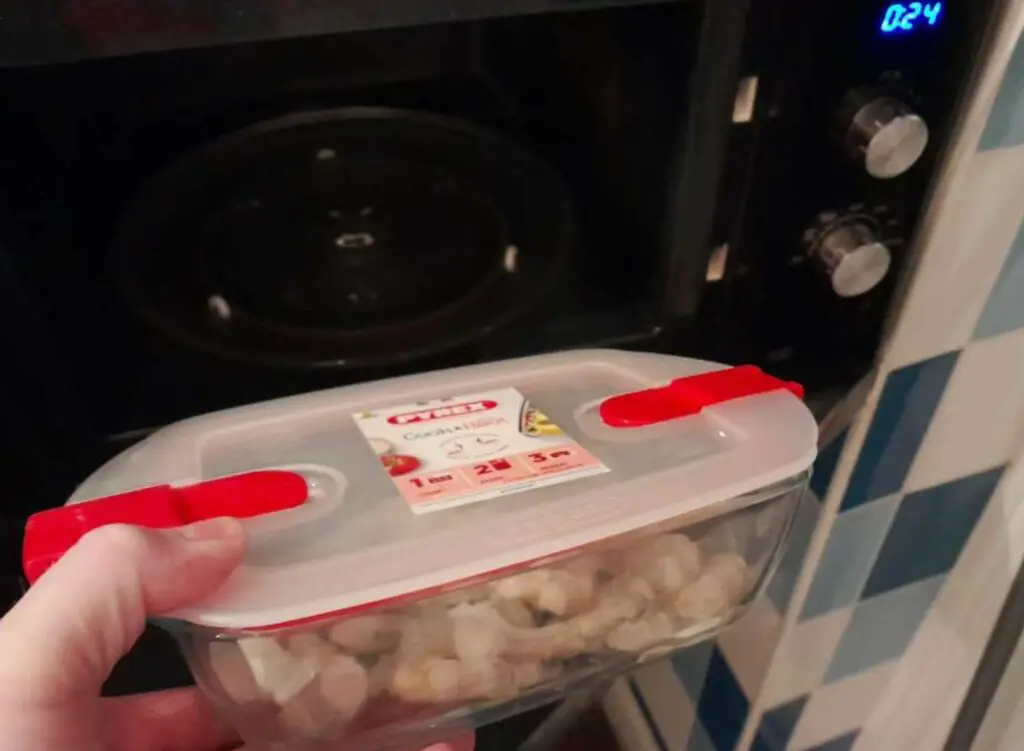
In all honesty? There is no universal answer. There are many recipes to cook shrimp; each has a specific how-to and little trick, depending on your final goal.
Nonetheless, there are certain rules you can follow to make sure that, regardless of the recipe, your result is a perfect, mouth-watering meal.
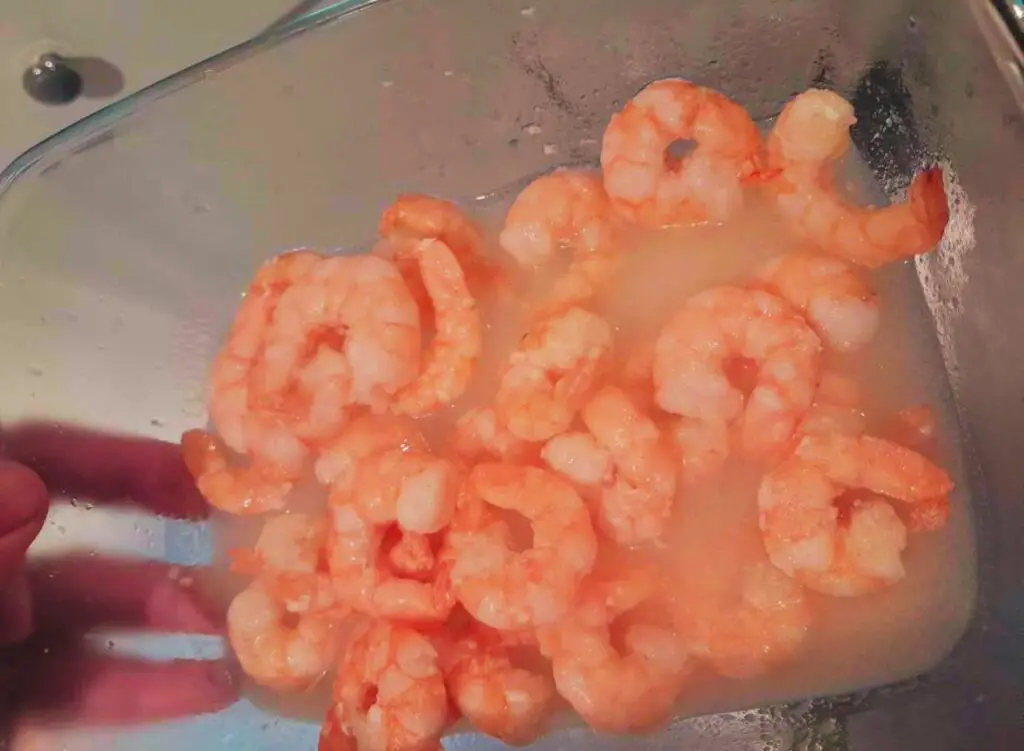
- Arrange the Shrimp: Place the frozen shrimp in a single layer in a microwave-safe dish. Make sure they’re not piled on top of each other, as this can cause uneven cooking.
- Add Water for Steam: Add two tablespoons of water to the dish for about a cup of frozen shrimp. This will generate steam to help cook the shrimp evenly and retain moisture.
- Cover the Dish: Use a microwave-safe lid or plastic wrap to cover the dish. If using a lid, leave it slightly ajar to let steam escape. If using plastic wrap, poke a few holes in it with a fork.
- Defrost the Shrimp: Set your microwave to the defrost setting (or 50% power). Microwave the shrimp in 1-minute intervals, gently stirring or rearranging them after each minute. This step is to thaw the shrimp without cooking them too much.
- Check If Shrimp Are Thawed: After defrosting, check if the shrimp are no longer frozen by touching them. They should be flexible but still cool.
- Switch to High Power: Now that the shrimp are thawed, switch your microwave to its regular setting (high power, about 1000 watts).
- Add Seasoning: Before you start cooking, add salt, pepper, and any other seasonings or marinades you like to the shrimp.
- Microwave on High Power: Cover the dish again and microwave the shrimp on high for 1-2 minutes. Keep an eye on them to avoid overcooking.
- Check for Doneness: Shrimp cook very quickly and are done when they turn opaque and pink. If they are not done after the initial 1-2 minutes, cook them in additional 30-second intervals, keeping a close eye to not overcook them.
- Let Them Rest: After cooking, remove the dish from the microwave and let the shrimp rest for a couple of minutes. This will allow them to finish cooking from the residual heat and lets the juices redistribute.
- Final Touches and Serve: If you want, you can add a squeeze of lemon juice for extra zing. Serve the shrimp while they are hot.
Remember, microwaves can vary, so it’s a good idea to be cautious with cooking times. It’s better to check frequently and add more time if needed than to overcook them from the start. Enjoy your perfectly cooked shrimp!
Is It Safe To Cook Frozen Raw Shrimp In The Microwave?
Yes! Cooking frozen raw shrimp in the microwave is as safe as any other method—proven that you follow safety standards.
To be safe to eat, shrimp should reach an internal temperature of 145°F (63°C) [2]. If you cannot measure it, you can follow visual cues.
Once cooked, the shrimp will turn from somewhat translucent and pale grey into white and pink. Likewise, the flesh will be firm; you can press it, and it will “bounce back.”
Can You Reheat Shrimp in The Microwave?

Yes, you can reheat already cooked shrimp in the microwave, but I do not recommend it. The shrimp can and probably will end up too hard and rubbery and might not smell so good either.
If you really really must use the microwave, place the shrimp in a microwave-friendly dish. Spread them out and cover the dish. Zap them on medium for about 1 to 2 minutes, but keep an eye on them to avoid overcooking. Just don’t get your hopes up for juicy shrimp if you’re using the microwave.
So, Should You Microwave Frozen Shrimp?
I’d say keep it as a plan B, especially if you’re serving a culinary expert like Gordon Ramsay.
Microwaving is quick and handy if you need to whip up a shrimp cocktail, garlic shrimp, or a shrimp stir-fry or shrimp salad fast, but there are some challenges in thawing or cooking frozen shrimp this way. That said, it doesn’t mean you can’t pull it off with finesse.
If you need to rely on the microwave, just remember: go gentle with the heat, use quick bursts of time, and keep an eagle eye on the shrimp and you will end up with juicy, tender, and delicious shrimp.
Sources:
- [1] U.S. Food and Drug Administration. Microwave Ovens. Retrieved from https://www.fda.gov/radiation-emitting-products/resources-you-radiation-emitting-products/microwave-ovens
- [2] U.S. Food and Drug Administration. Selecting and Serving Fresh and Frozen Seafood Safely. Retrieved from https://www.fda.gov/food/buy-store-serve-safe-food/selecting-and-serving-fresh-and-frozen-seafood-safely
